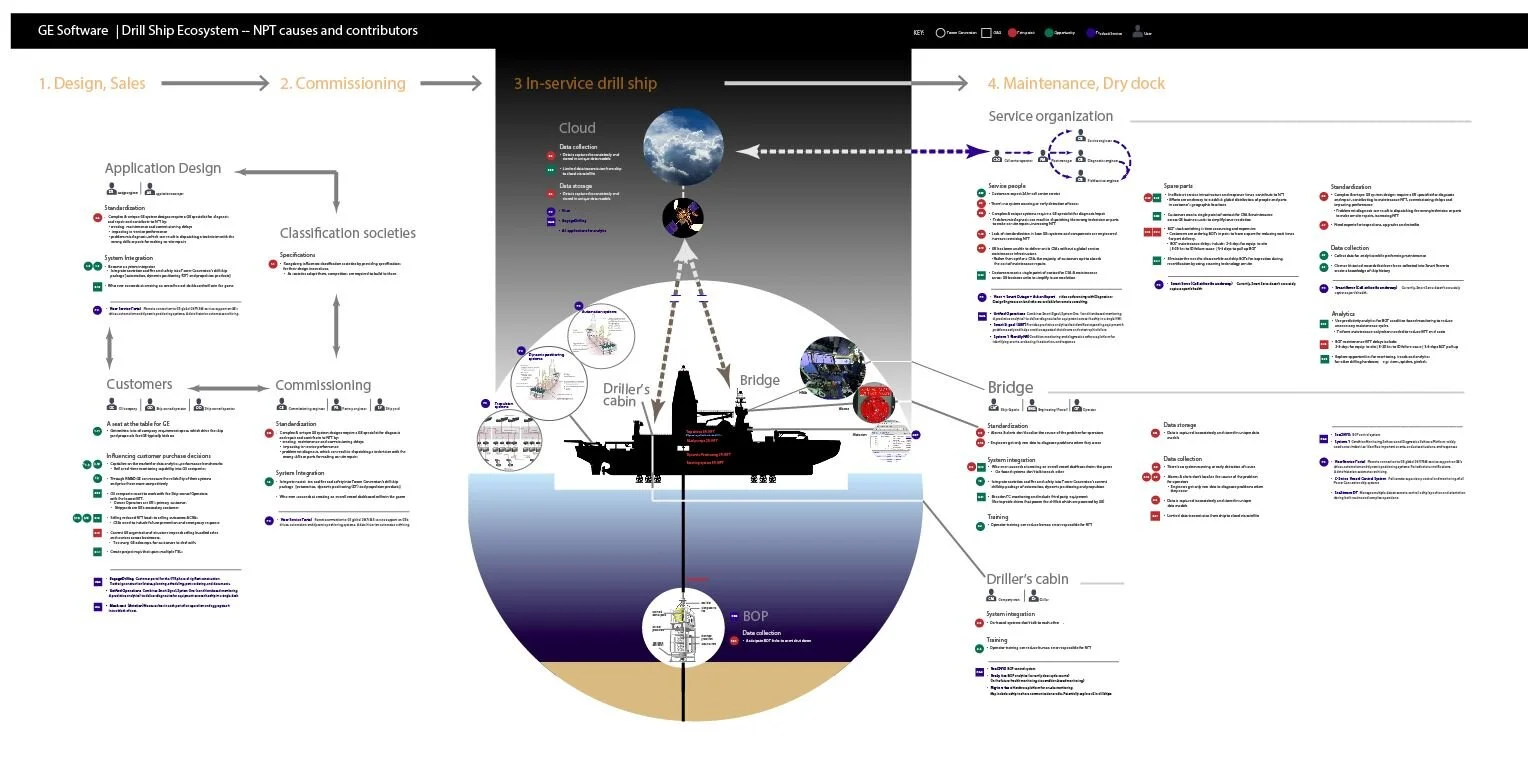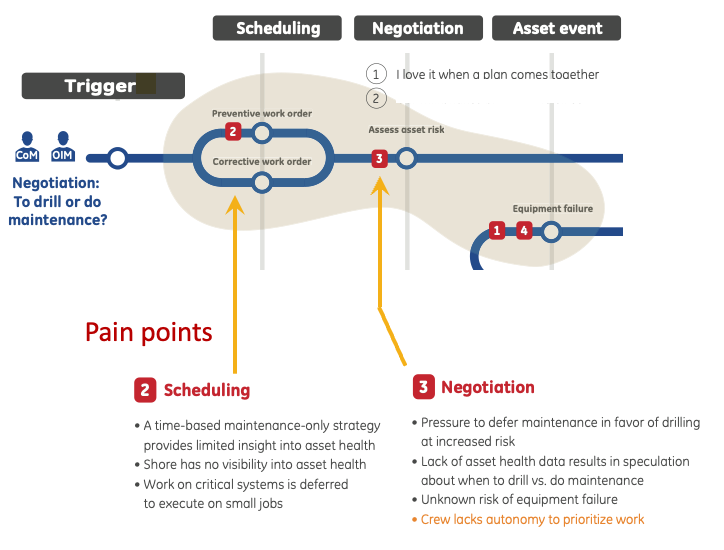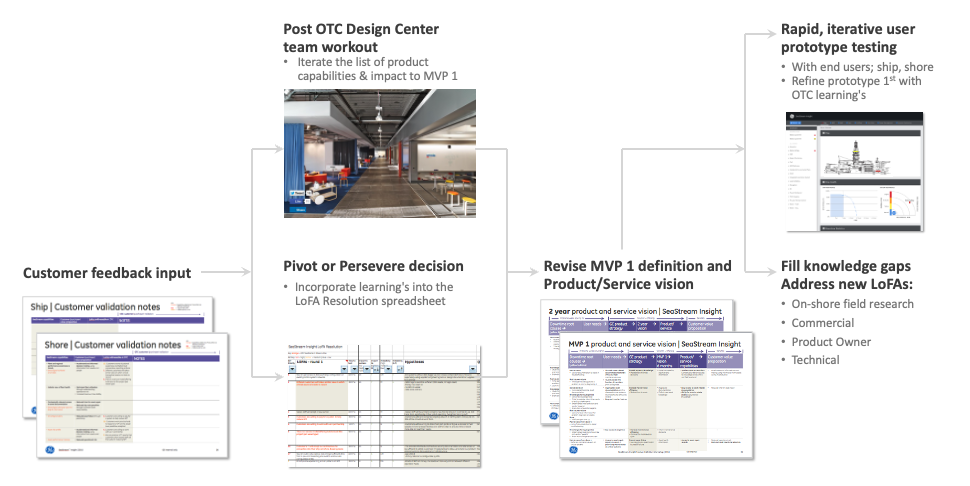Industry sector
using data insights to maintain & predict machine health
A new product offering for monitoring equipment health on oil drilling ships informs decisions about when maintenance is needed and increases human and machine productivity.
Client objective
Solution
A Power Conversion business had grown by acquisition.
Their offering consisted of one-off customer implementations and latent responses to market changes. They wanted to transition from a subsystem deliverer to a provider with a standardized product offering on a reconfigurable platform at a large scale. This required reconnecting with drill ship customers to identify opportunities for how data insights might address a pressing need—preventing ship down time.
Discovered how to reduce unproductive time on drill ships by 10% and increase the availability of onboard drilling assets. Identified the root causes down time and an opportunity for condition-based monitoring of ship assets to inform maintenance decision-making. Defined a product roadmap and MVP. Presented a working prototype to potential customers in a major power industry conference to gauge interest and test concepts. Sold the product into major oil drilling ship lines across the Gulf of Mexico.
team
Methodology
One Team—3 integrated discipline perspectives
Customer — UX, Market analysis
Business steering committee — parts of the business critical to the success of the roadmap. They provided regular feedback and guidance to UX work, identified funding sources, cleared barriers to on-ship research, communicated value of the work to leadership.
Technology — Architecture, Business analyst, Engineering
A UX-guided program approach led the way
Foundational research — Internal interviews, competitors, trends
Hypothesis building — Industry expert interviews, drillship ecosystem, Product/service evaluation
Customer research — Drill ship ethnography, feature prioritization workshop, concept test at OTC
Design iterations and development — Business case
The One Team approach was predicated on integrating 3 discipline perspectives
UX-guided the program approach
Foundational research INSIGHTS & Hypothesis
Identified where equipment down time occurs across the drill ship ecosystem. This was based on 26 interviews with internal company experts from Oil and Gas and Power industry verticals. Potential contributors to equipment failure were identified across the entire drill ship lifecycle — from it’s design and sale to commissioning, in-service work and off-line maintenance.
Expert interviews with drillship managers and workers identified causes of ship down time that the industry liked to keep hidden —
a lack of standardization, system integration, data; collection, analysis and storage, maintenance servicing, spare parts and training/knowledge sharing among the crew. (Maintenance servicing example below)
Hypothesis — Causes of drilling ship down time were identified for further research. The yellow areas below became the focal points for on-site drill ship research to seek out deeper insights about down time occurrences, situations and how they unfolded.
Ship ecosystem detail
Root causes of NPT
Insight: Market opportunity A market analysis confirmed that improving drill ship productivity by at least 10% by preventing equipment down time presented viable revenue generating opportunity upon which to sustain the business.
Drill ship research
Ethnography
Bridge — Captain, Senior Dynamic positioning operator, Dynamic positioning operator
Electrical Engineering — Chief electrician, Chief power distribution, Electrical and IT Supervisor, Technician
Mechanical Engineering — Chief engineer, 1st Mechanical engineer
Drilling — Senior tool pusher, deck pusher, Drill floor mechanical systems
Maintenance supervisor
Risk & safety
Drill ship field research
Personas of the ship crew
Journey maps
Stages of the Drillship Operations and Maintenance Lifecycle points to where down time occurs on-ship. Interviews with the ship’s crew helped confirm the root causes of ship down time at each stage. This is also where the team looked to identify and understand use cases for reducing it.
Stages of the Drill ship Operations and Maintenance Lifecycle and where NPT occurs
OPPORTUNITY FRAMING
Four Opportunity Scenarios were identified for reducing ship equipment failure by at least 10%.
Scenarios included the initiating triggers, personas and pain points that were mapped across stages of the ship’s Operational and Maintenance Lifecycle representing how and where failure points occurred and their avoidable, downstream impact.
Example Opportunity Scenario: (Journey map detail)
Without reliable information about the health of critical drilling equipment, the ship’s Chief Engineer (ship owner/operator) and Oil Company Man (contracting ship services) must speculate in deciding whether to stop operations to conduct maintenance or risk equipment failure and ship operational downtime for repairs, resulting in a significant loss of revenue.
proposed solution
Example — Plan maintenance around the operations schedule.
Condition-based monitoring of assets would provide data on asset health to inform negotiations about when maintenance can be postponed without risking asset failure.
This asset health information would be gathered by sensoring critical equipment. It would enable the Chief Engineer and Oil Company Man to shift maintenance to align with planned operational down time on shore and avoid interrupting drilling operations at sea unless warranted.
The Chief Engineer and Oil Company Man negotiate when to perform asset maintenance
Solution scenario
A scenario example — I Love it when a Plan Comes Together,
summarizes the current problem, pain points and needs and proposes a future vision/solution for a use case.
The future vision/solution describes what a condition-based monitoring solution would look like — its capabilities, customer value proposition, assumptions and risks.
Stakeholder Alignment Workshop
Evaluated 10 solution scenarios — for addressing 4 opportunity areas identified to reduce NPT
Feature prioritization — based on technical feasibility, customer desirability and business value
2 Product roadmaps — MVP roadmap, 2 year vision roadmap
Product strategy framework — addresses root causes of NPT through providing customer value
Product strategy framework
Engineering trimmed prioritized features and scoped MVP work to kick off the product build.
Product/service prototype
Product capabilities for providing asset health awareness —
Capture asset data to inform planning
Provide total situational awareness
Enhance operations through better decision making based on data.
Product architecture — Provides a view into equipment health at the fleet, ship and individual asset levels. Accessible by multiple user roles.
Product demo
Offshore Technology Conference — Product Demo
The product demo helped gauge customer interest and was used to capture feedback which used to iterate the product capabilities.
The first potential customer with a willingness to pilot the product on-ship was the shipping line where drillship research had been conducted.
CONCEPT ITERATION
Team approach to rapid iteration of the product concept and feature design with customer feedback. The product has since been sold into major oil drilling ship lines in the Gulf of Mexico.























